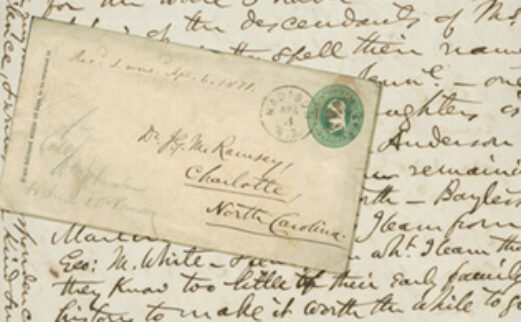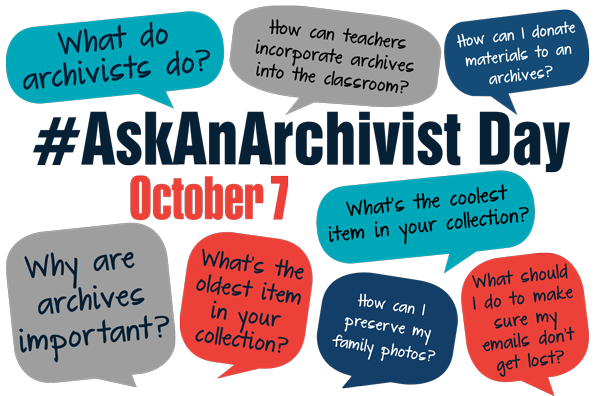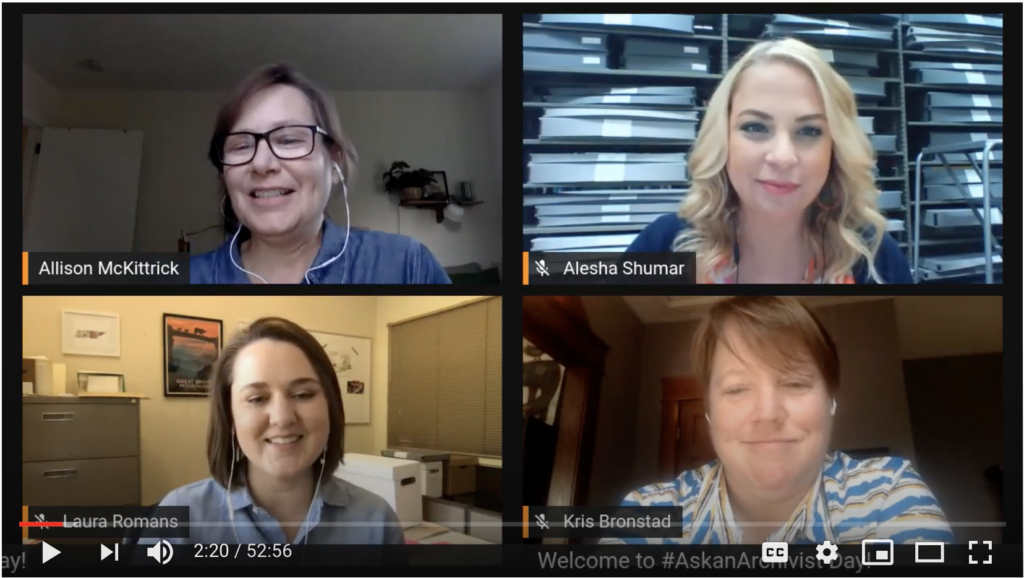
Curious about exactly what archivists do? October is American Archives Month, and on October 7, 2020, Ask An Archivist Day, UT’s archivists answered your questions on Twitter.

In preparation for Ask An Archivist Day, questions were solicited on social media. From there, librarian Allison McKittrick interviewed UT archivists Alesha Shumar (university archivist and assistant head of the Betsey B. Creekmore Special Collections and University Archives), Kris Bronstad (archivist at our Modern Political Archives in the Howard H. Baker Jr. Center for Public Policy), and Laura Romans (manuscripts archivist).

McKittrick first asked each of our archivists how they arrived at their profession. As it turns out, each had taken a similar path. Two began as undergraduate history majors; all three were student workers in their university’s archives and simply fell in love with the profession.
As an undergraduate history major, Romans took a work study job in her university’s archives. “I loved working more hands-on with history. Then I learned that you could get a masters in library and information science with a focus in special collections and archives.” Shumar, also an undergraduate history major, used the university archives for a history project and was so intrigued that she applied for a student job. Bronstad followed her brother and sister in working at the LBJ Presidential Library in Austin, Texas. All were inspired by their experiences to pursue a profession in archives.
Why, McKittrick asked, are archives and special collections important to a college library?
“We’re collecting rare, one-of-a-kind resources . . . It’s what makes us unique from every other college library across the country,” Shumar explained. “You can see how history is played out in primary documents. A lot of undergraduates get excited when they see the university yearbooks from the 1920s. ‘That’s what our lives would have looked like back then?’ It makes learning come alive,” Bronstad added.
Shumar told about her own excitement at entering the archives as an undergraduate and being allowed to use documents that perhaps “someone hasn’t seen in a hundred years . . . I was always amazed. I get to just come in here and touch and see these things that haven’t been outside an archival box in years? It was just fun. It took history from the books to the physical object, almost like a museum.”
Is there one thing our archivists would like first-year students to know?
“Simply that we exist and that they are more than welcome to use our materials,” Bronstad said. “We love that students learn about us in their first year,” Shumar added. “We hate for students to come in and say, I wish I had known earlier that this was here.”
Finding aids for the UT Libraries’ archival collections are available online at scout.lib.utk.edu.
But students are encouraged to bring their questions or research ideas to an archivist. “I believe students sometimes think we just have a few things — really specific interests,” Romans said. “But our collections are pretty vast . . . Just come to us with a question or idea, and we can try to figure it out together.”
How can students learn more about our special collections if they’re not on campus this semester?
They can begin by exploring our online digital collections at digital.lib.utk.edu. Because many of our archival and special collections are unique and rare, we continually digitize new collections and make them available online. “The most used are the most unique,” Shumar said. “All our yearbooks, our athletic programs — we’re going back through and digitizing those . . . Also, our archivists are available through email during the pandemic to talk about different collections and also to scan some materials you might not be able to come in and use yourselves.”
Do we work much with UT’s McClung Museum?
“McClung is a museum and we’re an archive, but we have similar goals,” Bronstad explained. Both build collections with the goal of preserving history. “Traditionally, the formats are a little bit different. The archives would collect the paper and maybe not the object as much, or the artwork. But now those lines are blurred,” Shumar said. The McClung Museum of Natural History and Culture and the Betsey B. Creekmore Special Collections and University Archives frequently lend materials back and forth for exhibit. “If they’re having exhibits or we’re having exhibits, we share that material to make sure the public gets to view it.” According to Shumar, “It’s not just that they have the artifacts and we have the paper; it really is that shared collecting goal.”
Why would special collections or archives want family heirlooms like old photos and letters?
I think of personal photos, personal heirlooms, as little microcosms of history.
UT’s archives, Roman explained, “collect and preserve things related to the culture and the history of our area. And that does come from the personal papers of people, of families, local organizations. Family heirlooms are some of the most unique things that there are. So, people’s letters, diaries, scrapbooks, photos — even if maybe they weren’t famous or super influential. But their materials can really give insight into a specific time, specific place, specific culture . . . I think of personal photos, personal heirlooms, as little microcosms of history.”
Shumar mentioned, as an example, how personal letters can convey what life was like during the pandemic that swept the globe a century ago: “I’ve gotten a lot of questions on what campus was like back in 1918 during the Spanish flu. We have the local student newspaper, and we have letters from students who were going home or joining the war effort of the time . . . Homecoming was cancelled the year before and so were a lot of the sporting events. So, we’ve seen things like this before. And the student experience . . . They were talking about how they were sad that their favorite things were cancelled and they didn’t have the same experience as in earlier years. But they were helping out with the war effort, making bandages – and masks, actually – in a room in the library at the time.”
The UT Libraries and other libraries around the country are gathering and archiving their communities’ experiences of the pandemic. How does that fit within the archive’s mission?
We don’t wait until history is made to record it and archive it.
“What I like to say is: we don’t wait until history is made to record it and archive it,” Shumar said. The University Archives began soliciting the campus community’s responses to the pandemic this past spring and will continue to gather input through next year. Shumar invites students, staff, and faculty to visit our Chronicling COVID-19 webpage to respond to a questionnaire. “I think that’s going to be very important for us to have 100 years from now.”
What does a day in the life of an archivist look like?
To the uninitiated, “archivist” sounds like a dull, repetitive job. “Trying to describe what I do to people who might not be familiar with the field . . . ‘Well, aren’t you just sitting in a room working with old books?’ No, not in the least!” Shumar exclaimed. “Some days, sure. But most days it’s a combination of everything. It’s talking to people about our collections, it’s trying to think of things that we can post and celebrate through one of the university’s many, many social media channels. It’s curating an exhibit, figuring out all the background information for one of our touch-screen exhibits. But for me it’s something I really enjoy. I’m always learning something that I had no idea I didn’t know . . . So, you’re not going to be locked away in a dungeon somewhere processing collections!”
Each of our archivists emphasized how varied — and often surprising — their days can be. Among their daily tasks are building relationships with donors who wish to gift materials to the archives; traveling (sometimes across the country) to pick up donated collections; processing collections — making an inventory, organizing, and describing materials, and taking fragile materials to our preservation lab for repairs or to construct special enclosures; helping with reference questions or conferring with students or faculty on their research; gathering materials for classes that are working with primary sources; curating exhibits and creating digital collections.
Overall, their efforts revolve around one goal: “It’s about making the collections available to people, making sure they are kept available and described in the right way so that researchers can find what they need,” Bronstad explained.
To learn more about what archivists do, watch our video interview with UT’s archivists.
For more information on the Betsey B. Creekmore Special Collections and University Archives, visit https://www.lib.utk.edu/special/.